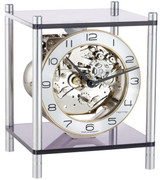Wall Clock Pendulum Tips
The pendulum is an important part of a mechanical wall clock. The pendulum helps regulate the speed of the clock. See our section on How Clocks Work for more information. Pendulums vary greatly in size, style and material. Most will include a long shaft of brass or wood. All traditional pendulums will also feature a “bob” of some sort, which will be a weighted cylinder disk or a weighted decorative piece. However, the pendulum itself is just a part of the larger pendulum assembly. Those important parts include the leader, crutch and suspension spring. The correct placement of these parts is crucial for the mechanical pendulum wall clock to run properly. We will briefly outline these parts, but our focus for this post will be the crutch and leader.
To help illustrate the pendulum assembly, we have pictured the back of an older mechanical pendulum wall clock we were servicing. Our pointer is pointing to the crutch. Specific gears inside the mechanical movement turn this brass part back and forth. The leader is the long silver vertical part that rests inside the crutch. The leader hangs from the t-hook on the bottom of the suspension spring. You can also see the pendulum hanging below the leader on the t-hook.
It's important that the leader is hung properly onto the suspension spring and that the leader is resting inside the crutch. New clocks will come with this proper orientation, as well as our retuned clock repairs. However, pendulums are not usually attached and will need to be placed on the bottom of the leader t-hook. What can happen, though, for novices when hanging the pendulum is that the top of the pendulum shaft pushes up against the bottom of the leader and pushes the leader off the suspension spring t-hook. When this happens, the leader will then slide down inside the crutch opening and almost fall completely through.
To remedy this, you can try to push the leader back up to the t-hook on the suspension spring. However, it may be easier to attach the leader on the suspension spring as one unit. To do that, you will need to unscrew the suspension spring screw, or take out the taper pin and take the suspension spring off the slotted post. With the suspension spring completely off and free in your hand, hook it onto the leader and then pull up this assembly up through the crutch. Then screw the suspension spring back on, or put the taper pin back in. As a side note, there should be some play in between the leader and the crutch, where our pointer is pointing to in the picture. You don’t want the crutch pinching the leader tight.
Although a detailed look at the suspension spring is outside the scope of this post, always make sure that the suspension spring is intact. A broken suspension spring will prevent the pendulum wall clock from working at all, even if the leader and crutch are properly situated. You will notice one of the two metal prongs torn if the suspension spring is broken. Just as the leader can come off the suspension spring when hanging the pendulum, the suspension spring can break too if not enough care is taken trying to hang the pendulum on a wall clock.
Recent Posts
-
Wall Clock Pendulum Tips
The pendulum is an important part of a mechanical wall clock. The pendulum helps regulate the …24th Apr 2025 -
Mantel Clock Speed Adjustment
Mechanical clocks are very reliable but will always need a mechanism to regulate the speed of the cl …10th Feb 2025 -
Bell Chime
Nothing speaks of modern sophistication like the Hermle Cygnus mantel clock 23035-x40340. …23rd Oct 2023




